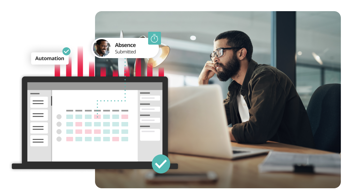How to manage absence in the workplace
Managing absence is a key priority for HR professionals, but according to the CIPD, few organisations effectively monitor the cost implications of staff absences on their business.
Unauthorised absences and absenteeism are costly and could be a sign of a wider problem, therefore it’s very important for staff absence to be managed effectively. Having visibility of absence data can improve efficiency and time management, while saving valuable money for the business. It’s also critical for large scale workforce management and planning, informing future policies, and mitigating risks to productivity, wellbeing and performance.
Keep reading to learn more about absence management and how to do it well with an advanced absence management system.
What this page covers
- What is absence management?
- What are the different types of absences at work?
- Causes of absences at work
- What is an absence management system?
- Benefits of using an absence management system
- The top strategies for managing absence
- How to prevent absenteeism
- Discover our powerful integrated absence management system
What is absence management?
Absence management is more than just approving annual leave and managing sickness. It involves using effective strategies and technologies to help your organisation track trends, get ahead of capacity challenges, reduce absenteeism, mitigate risk and ultimately make informed strategic decisions about your workforce.
Most organisations have their own sickness absence policy to help support and demonstrate compliance with occupational and statutory regulations and legislation regarding sickness absence. Effective return-to-work programmes, well-being initiatives, self-serve leave-booking functionality and flexible working options are all now considered best practice for HR and people managers, and fundamental to developing effective absence management strategies.

What are the different types of absences at work
Absences can be either planned or unplanned. Planned absences would include annual leave, which is planned and scheduled to align with company policies. Sick leave is usually unplanned but is a statutory right for employees. Employees can self-certify for up to 7 days and then provide a doctor’s note for longer absences. Maternity and paternity leave is planned in advance and allows the business to recruit maternity cover for the position.
Other types of absence may be a part of your benefits package. For example, you may provide employees with opportunities to take a day to pursue charitable endeavours. You can also incorporate mental health days into the benefits package.
Causes of absences at work
Employee absences are common challenges and they can disrupt productivity. However, whilst some absences are inevitable, understanding the causes can help businesses manage and reduce disruptions.
5 Common causes of absence
- Illness and injury – Short-term illnesses or workplace injuries are common across all industries.
- Family and personal responsibilities – Employees may need time off to care for family members or attend emergencies.
- Work-related stress – Workloads, deadlines, and workplace conflicts can lead to short and long-terms problems.
- Bereavement leave – The loss of loved ones can be emotionally overwhelming and time away from work is necessary for wellbeing.
- Doctor’s appointments and medical treatment – Employees may require time off for doctor’s appointments, dental check-ups, or ongoing physiotherapy.
4 Uncommon causes of absence
- Weather conditions – Extreme weather conditions could prevent employees from commuting safely.
- Transport issues – Unpredictable issues like disruptions and cancellations can occasionally lead to absences.
- Legal and civic duties – Jury duty or other legal obligations may require time off work.
- Personal circumstances – Unique situations like childcare arrangements falling through may require an unexpected absence.
Logging these absences and making notes on the circumstances in an absence management systems can give you valuable insights into your workforce planning. For example, if your system picks up trends with mental health absences, you can examine your staffing levels and wellbeing support to help your employees.
What is an absence management system?
First and foremost, effective absence management is reliant on good data. Measuring and monitoring absence, using data to identify trends and challenges, and then developing policies in response to these are the key steps to achieving effective absence management.
An absence management system should be part of any integrated HR solution like Access PeopleXD. Integrated HR software enables managers to track and report on absence whilst allowing employees more ability to self-serve - like requesting and managing their own holiday entitlement, all in a centralised cloud-based system.
Being able to easily consolidate employee data from across an organisation can help build an in-depth view of absence, including:
- Cost implications
- Absenteeism
- Employee engagement
- Wellbeing issues
- Whether people are being paid correctly
With effective absence management tools and robust data, leaders can prioritise their response and deal with these things in a strategic way.
Benefits of using an absence management system
Manage absence across a large and disparate workforce
Whether hybrid or fully remote, desk-based, or on-site - or a combination of these - cloud-based systems will enable your workforce to book holidays wherever they are and empower managers to act on these requests and make decisions just as easily. Managers can approve and track recurring absences and rearrange shifts and work schedules to accommodate for employee leave.
Use centralised absence data to support capacity planning and scheduling
The ability to capture absence data at source in a system that also integrates with your wider workforce management, scheduling, and rostering processes, is important for predicting times when there are increased levels of absence in your organisation. For example, more people taking annual leave during school holidays and more people taking sick leave during the winter. A wider visibility of holidays booked across teams also helps prevent clashes and avoids impacting the productivity of specific teams or departments, as well as which employees are failing to take their annual leave entitlement. Our Annual Leave Report 2024 shows that the number of employees taking annual leave has dropped 7.67% from 2022 to 2023, it’s more important than ever to proactively encourage staff to take their holidays throughout the year..
With a more accurate view of potential sickness absences, time worked, and holidays booked across the organisation, scheduling is much simpler, and can be readjusted in real time. This scale of workforce capacity planning is particularly vital for organisations with hourly rate shift-based staff in order to identify where extra resources or cover may be required and ensure the right level of staffing in busy periods.
Reduce errors and improve accuracy
Tracking time, attendance, holidays, and absence across a large workforce can be challenging, not to mention costly, without having a single source of truth when it comes to data. An integrated absence management software that shares data with your other HR software, such as your workforce management and payroll systems, helps prevent duplicate records, human error and ensures a more accurate payroll.
An automated absence management system can help reduce errors and save on administration time. For example, absence management software should be able to make automatic pro-rata adjustments for new starters and leavers, as well as changes in full time equivalence (FTE), length of service and promotions, removing the need for manual processes, in turn improving accuracy.
Save time by automating processes and pay
A major benefit of absence management software is the ability to automate processes, freeing up your HR team to focus on more strategic initiatives. You can automate clocking in and out processes, and automatically calculate holiday entitlement and pay – based on your organisation’s specific requirements – as well as statutory sick pay, maternity/paternity/shared parental pay, and unpaid leave where there is no statutory entitlement to pay.
As an example, Cineworld Group PLC have made considerable time savings with our absence management systems. Tom Manning, Operations Project Manager at Cineworld says, "A task that took six hours to write a roster now takes less than 60 minutes. Holiday requests and shift swaps are automated, taking no management time. It’s not very often we get the chance to hand back five hours to every senior manager every week."
Read the full Cineworld case study.
Improve the employee experience with self-serve functionality
The latest absence management systems will deliver secure ownership of access into employees’ hands, enabling them to:
- Manage their own personal records
- View annual leave entitlement
- Request and check holiday approvals
- Book time off in-lieu
- Clock-in and out
This removes admin time for managers, speeds up processes and avoids confusion over holidays left to take.
Some systems feature mobile apps too, making annual leave processes for employees and managers even more flexible and generally enhancing the employee experience. Our self-service HR software, for example, can be integrated with absence management modules.
Get to grips with the cost of absence
Sickness absences have soared into 2023, with a 55% national increase in sickness absence rates since 2019. This indicates that businesses could be facing an industry-wide issue as a longer-term impact of the pandemic.
Industries are faring differently when it comes to the number of staff taking sick leave. For example, those working in the real estate sector saw a huge spike overall, with a rise of 67% in recorded sick leave in the last year, whilst the recruitment sector recorded an increase of 16% in sickness rates - from an average of nine per company in 2022, to 11 in 2023.
Integrated absence management systems can shed light on the cost impact of absence across your organisation and will feed data automatically into your payroll to ensure you are paying people correctly. It will also help to reduce costs by understanding the root cause of sickness absences.
Better understand your absence data patterns and trends
Absence management is more than just tracking leave. The data generated from integrated systems enables you to analyse absence patterns and trends in detail and plan, strategically where to focus resources to deal with any challenges with absenteeism and to mitigate future risks.
With tools to notify managers automatically of trends to be investigated, organisations can begin to develop a more proactive approach to managing sickness and associated costs. Having integrated systems enables managers to get a dashboard overview of absence, and drill down into concerning areas by department or individual.
Support the health and wellbeing of your people
Research by the Department for Work and Pensions showed that the majority of employers agreed that there was a link between work and employee health and wellbeing (91%).
However, for too long many organisations have had a negative view of absence. But the reality is, work-related stress, anxiety, and depression now account for more than half of all sick days taken in the UK and mental ill-health is costing UK employers up to £7bn a year.
Absence management data can be used to inform wellbeing strategies and to reduce the costs associated with absenteeism such as:
- Decreased productivity
- Hiring temporary staff
- Outsourcing workpaying staff overtime to complete work
- Impacting the wider team wellbeing from increased workloads.
Managing these things will help reduce the risks of wider cultural issues of poor wellbeing. Learn more about supporting your workforce with our health and wellbeing hub.
Identify and prevent the effects of presenteeism
Presenteeism is costing UK organisations more than four times as much as mental ill-health related absences and with nearly half of HR leaders acknowledging that burnout is responsible for up to 50% of employee churn. We can use insights from an absence management system to identify presenteeism challenges and use strategically to put in place way to create a working culture that helps reduce and ultimately prevent stress and burnout and decrease staff turnover.

Absence management best practice guidance
Calculate and measure absence
Wondering how to monitor sickness absence? There are different ways of effectively measuring absence; whether that’s percentage of lost time, frequency rate of absences or a mixture of the two using the Bradford Factor formula to identify challenges with absenteeism.
These things all have their own advantages and challenges and no one measurement should be used in isolation as a strategy to manage absence, but these should be used as a guide and a way of setting automated triggers in your absence management system.
Set automated triggers to manage staff absence
Setting trigger points within your system will help flag issues to the appropriate person in real time. Your system should allow you to set automated rules to help you enforce your sickness absence policy, including triggering return-to-work processes and notifying managers of potential absenteeism based on whichever calculation your organisation uses.
Conduct return to work interviews
By following up each instance of absence by conducting return-to-work interview, you can help to identify individual reasons and wider trends, as well as track recurring absences and put in place processes with line managers to better support employees on an individual basis.
Provide line manager training and support
Many organisations place an expectation on their line managers to handle absences and provide support to employees. However, to manage staff absence effectively, line managers will require appropriate training to do so, both in understanding your organisation’s sickness absence policy and their role in your absence management process, but also in the communication and support skills required to support employees.
Effectively managing sickness absence at work requires those responsible to have a good understanding of the legal and disciplinary aspects of absence, how to use your absence management systems and how to conduct return-to-work interviews as well as awareness of the more sensitive mental health and wellbeing issues they may need to raise and discuss with their teams.
Create policies that align with UK guidelines to manage absence at work
Your sickness absences policy should support and reflect your culture and organisational objectives and explain what is expected of employees along with their rights when it comes to sickness absence. They should be made aware of when and who employees should notify in the case of being unable to attend work, along with the terms of your self-certification process and when a doctor’s note may need to be provided.
Any specific terms and conditions must by law be provided to staff. For example, incapacity to work, provision of contractual and statutory sick pay and your sickness review or trigger system will need to be explained.
To learn more, download our latest annual sick leave report
How to prevent absenteeism
Reducing absenteeism in the workplace can be achieved through simple yet effective steps. These include:
Prioritise well-being and engagement
Research suggests that providing early intervention strategies for employee wellbeing can help avoid stress, burnout and absenteeism, and indeed, pre-emptive strategies have been found to achieve higher returns than those brought in later when there are issues that require tackling.
With a massive 90% of people admitting they will never cite stress, anxiety or depression as reasons for their absence, absence data should be analysed carefully when considering these things as potential causes and with plans to deal with presenteeism as part of this. A strategic approach to asking employees for feedback and how they can be better supported is a good way to encourage open communication and together with absence data, can help organisations address any challenges before they escalate.
Embrace flexible working where possible
Research suggests that access to remote or more flexible working can help with managing absence at work. It shows that more flexibility over where and how we work can have a dramatic impact on employee wellbeing, productivity, innovation, and inclusion and can decrease cases of burnout by more than a quarter (26%).
Organisations that trust employees with the autonomy to choose how best they’re able to work and encourage them to bring their whole selves to their role are likely to see improved levels of engagement, retention and wellbeing as well as reduction in sickness absence, absenteeism and presenteeism.

Discover our powerful integrated absence management system
PeopleXD is The Access Group’s fully integrated HR software suite which includes a dedicated absence management module, helping you to manage your people data across multiple areas of the workforce. The suite is fully AI-enabled, giving you instant actionable insights and answers faster than ever before. Copilot, your AI HR assistant, instantly answers questions, automates tasks, and generates content based on HR best practices. Built-in analytics provide real-time insights to identify trends and accelerate business impact. The AI feed automates workflows and keeps employees informed of key tasks.
With an extensive dashboard, HR leaders and line managers get an at-a-glance view of staff absence data, whether that’s holiday leave or sickness absence, and the ability to drill down and analyse this in as much detail as is required. Understanding absence can help inform workforce scheduling, absence strategies and wellbeing programmes, and ensure an accurate payroll.
Find out more about our HR software
Learn more with our HR and Payroll blogs
Our HR and payroll blogs offer advice and guidance from industry experts.










